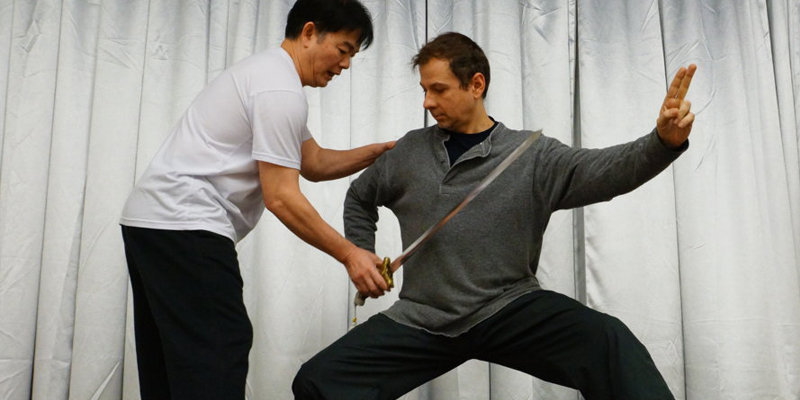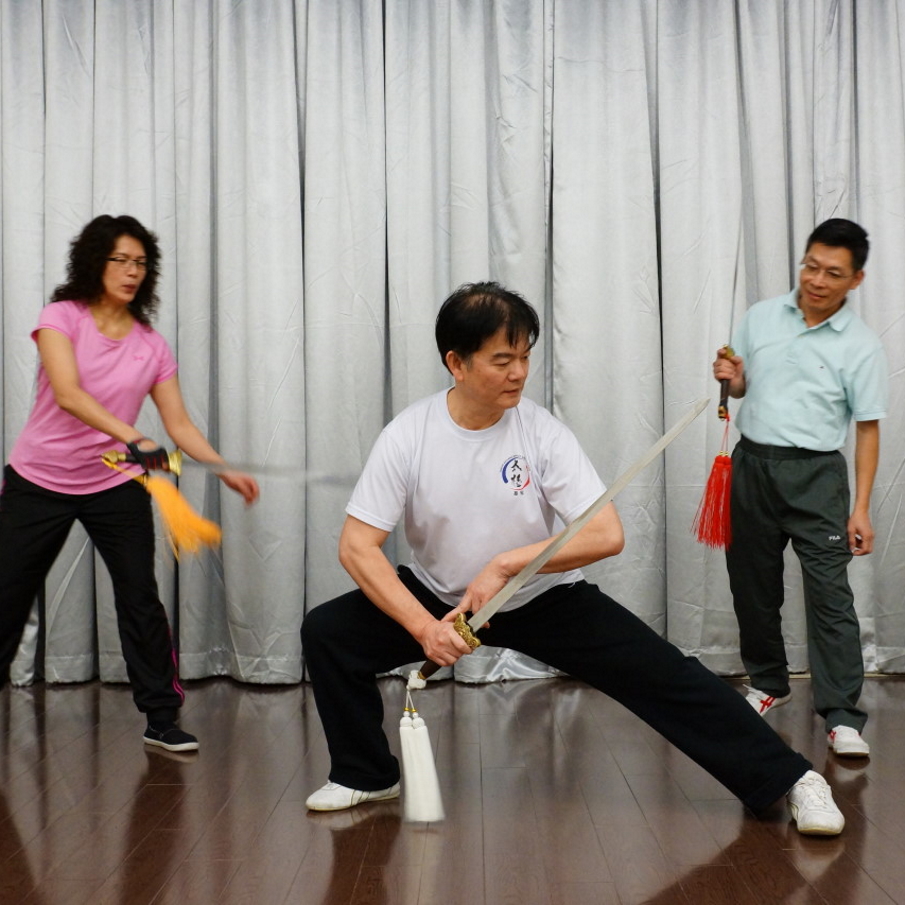For some people, one look at the schedule and they are instantly drawn to the Tai Chi Sword class. They find it both exciting and exhilarating even to think about wielding a sword with some degree of competency. If you feel this way, you can get some background information throughout this blog to make your experience in class that much more enriching.
For many others, seeing Tai Chi Sword on the class schedule will pique their curiosity and make them wonder if it’s for them. It may also seem intimidating to some people. If you feel this way, you may be wondering if you are ready or if you will enjoy yourself or if you will be coordinated enough to accomplish all the movements. This blog will help you figure out if Tai Chi sword is right for you.
What’s Fascinating about Tai Chi Sword
Of the four main tai chi weapons: long pole, spear, sabre and sword, the sword is the lightest weapon. The sword requires only one hand to wield and people are often entranced by the graceful, intricate and fluid movements.
This explains why the sword is the most popular weapon to learn amongst tai chi students. Now, even though the sword may have the most appeal and seem easiest to learn, in reality, it is the most difficult of all the weapons to master.
The sword form is beautiful to look at, and just like any performance, the movements require dexterity, balance and precision to be flawless while appearing effortless to the observer.
Fundamental Tai Chi Sword Techniques
The Tai Chi Sword is a double edged straight sword with a long history in Chinese martial arts with a variety of additional characteristics. Regardless of the additional characteristics and names for the different types of swords, all double edged straight swords perform 4 specific actions.
- Point – this applies to movements where power travels to the tip of the blade hitting the target at the blade tip. Point techniques typically feel like a flick or a whip.
- Thrust – this applies to movements where the arm is flexed and extended making a straight line from arm to sword handle to sword tip. Power extends from the arm onto the entire sword blade. The tip of the blade connects with the target first and the rest of the blade follows through at the same connection point. Thrust techniques have motions that are led by the sword tip.
- Cut – this applies to movements where the sword hits the target along the edge of the blade with power focused about mid-length of the sword where the blade meets the target. Cut techniques have motions that are led by the sword edge.
- Slice – this applies to movements where the sword connects to the target along the edge of the blade at one point and travels to another point on the edge. That means power is exerted on the sword edge and slides along the blade following the changing contact point. Slice techniques typically have a circular and fluid feel to it.
Learning each type of movement and the focus of each is important to knowing how to focus the body’s power or jing. Body movements and focus will be different in each action. Knowing which action is being executed will change the mental and physical focus of body movements used to accomplish each. Numerous challenges in posture and balance will occur due to the addition of a weapon in the hand but more than physical movements, a lot more mental focus is required to focus the body and sword to act in a precise and controlled manner.
Tai Chi Sword Proprioception and Mastery

Unlike the other weapons, not only do we need to move the sword into position in a striking motion at the target but the sword needs to flow through the air following a very specific path throughout the entire motion. The 4 main types of sword techniques each require movements that travel in very different paths. The practitioner must know the technique, understand the path and be able to guide the sword along the exact path with the utmost precision.
While it is easier to use a sword because it is lighter, it also means that people must take extra care even when walking with the sword in hand. One needs to be vigilant and intentional when carrying a sword or you may cut yourself or worse, someone else around you.
To be able to practice the sword with precision requires your full attention. Your mind is on full alert, constantly observing and following the prescribed path for the sword. When you practice this way through the entire sword form, you find yourself exhausted mentally more so than physically.
Using the sword is like a dance with your sword. In the beginning, you are just following the steps and completing the action in a technical way, often getting in the way of the sword and moving awkwardly. With a great deal of practice, mental focus and precision of motion, the sword slowly becomes a mere extension of the martial artist.
You will begin to sense the entire sword as an extension of your own body from the blade through to the tip. You will no longer think of how to move the sword to where you want it to go, but you will think of where you want to go. You and your sword become one.
Tai Chi Sword to Enhance Balance and Posture
Long before we achieve this level of mastery, working with the sword will challenge all the basic concepts of tai chi balance and posture. Whenever we add a weapon to our practice, we are adding a weight with some length that challenges our sense of balance. If we are not paying attention, our posture will tilt. We constantly need an increased awareness and focus on both posture and balance while practicing the sword form.
Students are ready to learn Tai Chi Sword when they have enough experience to know how to maintain the 5 bows in their posture in any variety of empty hand tai chi forms. The 5 bows posture ensure the strength and flexibility within the body to move without losing balance or being knocked over by either the added weight of the weapon or by contact with external elements.
Maintaining the proper 5 bows posture for strength throughout the key joints of the body is difficult even in empty hand forms. Adding the sword and having to guide it through a specific path creates new challenges. Advancement of this skill takes a lot of practice with both the sword and empty hand forms. And, it takes even more time to fully master.
Finally, we challenge our ability to use the energy of the body with intention to create movement. This intention starts at our dantien which is at our body’s core. In an empty hand form, this energy moves from dantien to shoulder to elbow and finally hand. With the sword, the energy now has to be transferred from dantien to shoulder to elbow to the hand and finally into the sword.
To achieve this principle, you need absolute control of the sword both mentally and physically. Using a simple movement of sweeping the sword from left to right, you have to hold the sword steady while waiting for your dantien or core to shift to the right. Next, your body turns and then your arm starts to pull the sword to the right. All the while, you hold the sword steady until your core has shifted before the elbow begins to lead followed by the hand directing the motion. Finally, the energy is directed through the sword to finish the path and intention of the movement.
This unfettered direction of energy is where the swordsman gains the power to wield the weapon both effectively and powerfully. Very often we can judge the skill level of a swordsman by how steady the sword is held throughout the entire range of each movement.
Tai Chi Sword for Fun and Fitness
One of the main reason we practice tai chi together is for fun and fitness.
In modern society, we do not practice the sword for self defense or survival. So most of us will never achieve the level of master swordsman, but this should not stop us from learning the sword or the joy of learning it.
There are two basic requirements that I ask of my students who want to learn tai chi sword. Firstly, know the tai chi basics and have practiced an empty hand form for at least 6 months to a year. Your readiness depends on how diligently you have been practicing the details of your form throughout the months and years. Secondly, bring your full attention to class so you know exactly where your sword is at all times for your own and other people’s safety.
Learning tai chi sword is hard work but the rewards are worthwhile. There are no words to explain the exhilaration and joy of moving and being one with your sword until you have tried it for yourself. People just have fun when it comes to Tai Chi Sword!




[…] Of the four main tai chi weapons: long pole, spear, sabre and sword, the sword is the lightest weapon. The sword requires only one hand to wield and people are often entranced by the graceful, intricate and fluid movements. This explains why the sword is the most popular weapon to learn amongst tai chi students. via […]
[…] Some practitioners only practice tai chi for health and fitness benefits, with no interest in developing fighting skills. It is likely because its martial arts applications have a higher risk of injury, or these practitioners already have the basic kung fu or wushu skills. Still, when you practice with a sword, it helps improve your balance and strength. […]
[…] Certains pratiquants pratiquent le tai-chi uniquement pour des bienfaits pour la santé et la forme physique, sans aucun intérêt à développer des compétences de combat. C’est probablement parce que les pratiques d’arts martiaux ont un risque plus élevé de blessure, ou parce que ces pratiquants ont déjà les bases kung-fu ou wushu compétences. Mais si vous pratiquez avec un épéecela vous aide à vous améliorer équilibre et force. […]